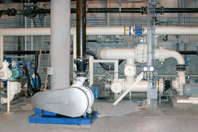ODOR CONTROL RESOURCES
-
The South Dearborn Regional Sewer District in Lawrenceburg, Indiana, provides regional wastewater treatment services for three cities and an international distillery. The 6 mgd treatment plant is located in an area of high population growth and is surrounded by many retail operations and other commercial developments. In addition, a heavily traveled state highway runs by the treatment plant.
-
Faced with persistent odor complaints and limited space, Douglas County Sewer District #1 in East Wenatchee, Washington, turned to the ThermAer second-generation Autothermal Thermophilic Aerobic Digestion (ATAD) system to modernize its biosolids treatment.
-
Faced with soaring ammonia loads—especially during race weekends when 250,000+ fans descend on the town—the Speedway, Indiana Wastewater Treatment Plant was in urgent need of a solution.
-
Calera Creek Water Recycling Plant, located in Pacifica, California, recently retrofitted to the Thermal Process Systems’ ThermAer™. This is California’s first installation of the second generation ATAD system.
-
The Suffolk County Department of Public Works tested the effectiveness and cost-efficiency of PRI-TECH® in controlling odors at a wastewater treatment plant. The technology successfully treated odors and reduced operating costs.
-
Cabo San Lucus Mexico is known for its deep-water fishing, beautiful beaches, luxurious hotels, and as an overall vacation destination for travelers from around the world.
-
Turning your water tap on only to be encountered by a terrible stench is arguably one of the worst ways to start your day. Your immediate reaction may be to assume that your water supply is contaminated, but there are myriad reasons why your household water has suddenly developed a pungent odor.
-
The Plant’s wastewater treatment facility uses four, covered anaerobic lagoons to manage BOD, pretreating wastewater prior to sending the effluent to a pumping station which directs the wastewater into the municipal collection system for final treatment at the City’s wastewater treatment plant. Read more to learn how the company used hydrogen peroxide and a catalyst to maintain an aerobic environment but was unable to adequately mitigate the odor from the facility’s wastewater.
-
Wastewater from the meat processing facility is treated using a sequence batch reactor and an aerobic lagoon that discharges to surface waters following treatment. The facility replaced surface aeration equipment with two, 350-HP the “no-splash,” side-stream SDOX systems retrofitted to the treatment basin. Read the full case study to learn the results.
-
Officials at the Jefferson Parish Sewerage Department approached the team at Digital Engineering to find a long-term solution for the odor and corrosion issues throughout the East Bank Wastewater Treatment Plant.
-
After researching different ozone systems, plant officials ata 12 MGD wastewater plant in Arkansas chose to install BlueInGreen’s HyDOZ technology in order to more efficiently meet current permit requirements, as well as prepare for future legislation.
-
Learn how the Millsboro processing plant replaced mechanical surface aerators with SDOX technology to fulfill the oxygen needs of the various biological treatment processes without interrupting operations.
-
The wastewater pre-treatment plant processes effluent from the manufacturing facility prior to discharging into the sanitary sewer system for treatment at the municipal wastewater facility. Use of sulphuric acid to manage the pH of the wastewater in the buffering reactor tank prior to entering the DAF for solids and oil removal was considered to be an unnecessary risk requiring significant safety protocols.
-
Natura Solve provides a complex liquid medium that is produced via a proprietary fermentation process. It consists of a selected spectrum of naturally occurring microorganisms, sustained within a matrix of micro elements and macro elements that provide the critical building blocks for respiration and growth. Thus it simultaneously works as both a biocatalyst, stimulating endogenous bacteria metabolic and production rate and a specialized delivery medium for the highly effective bacteria. The formula is very aggressive due to the essential balance between the selected groups of microorganisms, which, when combined with the enzymes they produce, synergistically create catalyzing proteins that significantly speed up the biochemical reactions and natural decomposition processes of the organic material into humic matter.
-
The South Dearborn Regional Sewer District in Lawrenceburg, Indiana, provides regional wastewater treatment services for three cities and an international distillery. The 6 mgd treatment plant is located in an area of high population growth and is surrounded by many retail operations and other commercial developments. In addition, a heavily traveled state highway runs by the treatment plant.
-
Faced with persistent odor complaints and limited space, Douglas County Sewer District #1 in East Wenatchee, Washington, turned to the ThermAer second-generation Autothermal Thermophilic Aerobic Digestion (ATAD) system to modernize its biosolids treatment.
-
Faced with soaring ammonia loads—especially during race weekends when 250,000+ fans descend on the town—the Speedway, Indiana Wastewater Treatment Plant was in urgent need of a solution.
-
Calera Creek Water Recycling Plant, located in Pacifica, California, recently retrofitted to the Thermal Process Systems’ ThermAer™. This is California’s first installation of the second generation ATAD system.













